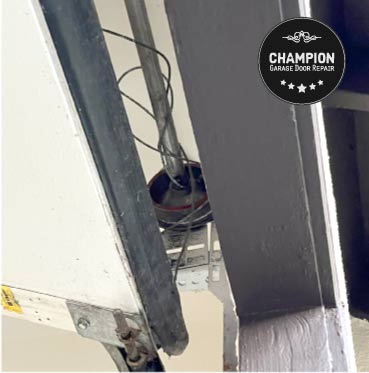It’s no secret that garage doors are an essential part of any home, but even the most reliable overhead door systems can experience issues from time to time. According to a recent survey, six out of ten homeowners reported a common problem with their garage doors: a tangled door cable.
Homeowners with older garage door systems, or those who neglect regular maintenance, are at a higher risk of experiencing cable-related issues, such as the door coming off its tracks. Conversely, newer and well-maintained garage doors are less likely to break down in this manner.

In this article, we explore the reasons behind this frequent issue, its impact on homeowners, and how you can prevent it from happening.
9 Most Common Reasons Your Door Cable May Get Tangled
1. Objects Getting Caught in the Doorway
One of the most common reasons your garage door cable may become unraveled is when objects get caught in the doorway as it’s opening or closing. Loose bolts on the door tracks, garden tools, boxes, paint cans, ladders, or any other item can cause the cable to jump off the pulley and derail your garage door. To prevent this issue, ensure all bolts on the tracks are tightened and keep your belongings away from the garage door and its tracks.
2. Worn Garage Door Bearings
Garage door bearings hold the torsion tube in place and typically rotate with it when the door opens and closes. A worn bearing can cause the torsion tube to stick or bind, leading to the cable coming off the pulley. To preserve the condition of the bearings, ensure the torsion assembly is properly aligned and that the garage door is sealed to prevent contaminants from getting inside. Additionally, lubricate the bearings every few months to maintain their functionality.
3. Rust and Corrosion
Rust and corrosion can significantly impact your garage door components. These elements can eat through the cable threads, and since the cable is under high tension, it is more susceptible to breakage than other parts of the door. To protect the cables, ensure your garage door is properly sealed to prevent exposure to moisture and contaminants. Replace any rusted cables promptly to avoid sudden breakage and prevent the door from coming off its tracks.
5. Incompatible or Worn Garage Door Springs
The garage door torsion springs not only counterbalance the door’s weight but also keep the cables under tension on the pulley drum. If the springs do not exert the correct amount of tension, the cable may slacken, causing it to come off the pulley drum. Ensure that your garage door is balanced, and adjust the springs’ tension as necessary. Replace worn or broken springs promptly to prevent further issues.
6. Worn or Broken Rollers and Hinges
The garage door rollers and hinges allow for smooth and steady movement along the tracks. If a roller or hinge wears out, it can cause the door to bind or stick while opening or closing, resulting in jerky movements and potentially causing the cable to jump off the pulley drum. Inspect and lubricate the rollers and hinges every 6 to 12 months. Ensure the hinges are securely fastened, regularly tightening screws, and replace worn parts as needed.
7. Worn Garage Door Sections
Worn, cracked, or bent garage door sections may buckle under their own weight when the door is open. This can cause the garage door to stick and the cable to jump off the pulley. Repair worn sections with designated garage door reinforcement struts. If the sections are beyond repair, replace the sections with the appropriate corresponding panels.
8. Bent or Damaged Door Torsion Tube
A bent or damaged torsion tube can cause uneven rotation and movement of the torsion assembly, which may result in the cable jumping off the pulley drum. Replace the torsion tube promptly to prevent breakage and avoid further complications.
9. Misalignment Problems
Misalignment of the garage door tracks, supporting brackets, or torsion assembly can cause the cable to come off the pulley due to uneven movement of the door. Misalignment may result from shifting foundations, regular wear and tear, or faulty installations. Regularly inspect your garage door, torsion assembly, and tracks. Align your overhead door system as needed, and ensure that the support brackets are properly secured to the wall.
How Broken or Tangled Garage Door Cables Can Affect You
Broken or tangled garage door cables can significantly impact the functionality and safety of your garage door. If one of the cables comes off the pulley while your garage door is in an open position, the door may not close, leaving your garage and home vulnerable to outside threats and the elements. In more severe cases, the garage door may come off its tracks or even crash down to the ground, posing a serious safety hazard.
How to Detect a Broken or Tangled Garage Door Cable
Several symptoms may indicate that you’re experiencing issues with your garage door cable:
- The garage door appears crooked or misaligned.
- One side of the door is higher than the other.
- The garage door is sticking or binding during operation.
- One or more of the garage door panels are off track.
To verify that the garage door cable is indeed malfunctioning, inspect the cable for any signs of breakage or confirm if it’s misplaced (tangled around the pulley drum).
What to Do When Your Garage Door Cable Is Malfunctioning
First, do not force your garage door to close or cut the cables to shut it, as this may:
- Cause the garage door to fall off the tracks.
- Result in the door slamming shut.
If you are technically inclined, you can attempt to repair the cable by wrapping it back onto the pulley. Otherwise, contact a licensed garage door repair company in your area. Ensure that the company provides an emergency service and can come out the same day to fix your door.







